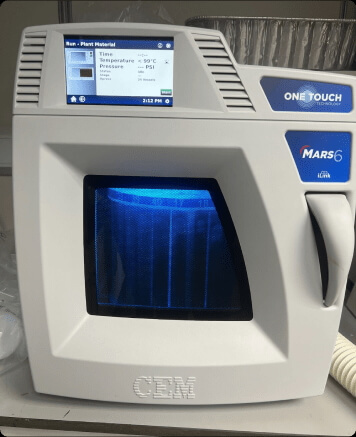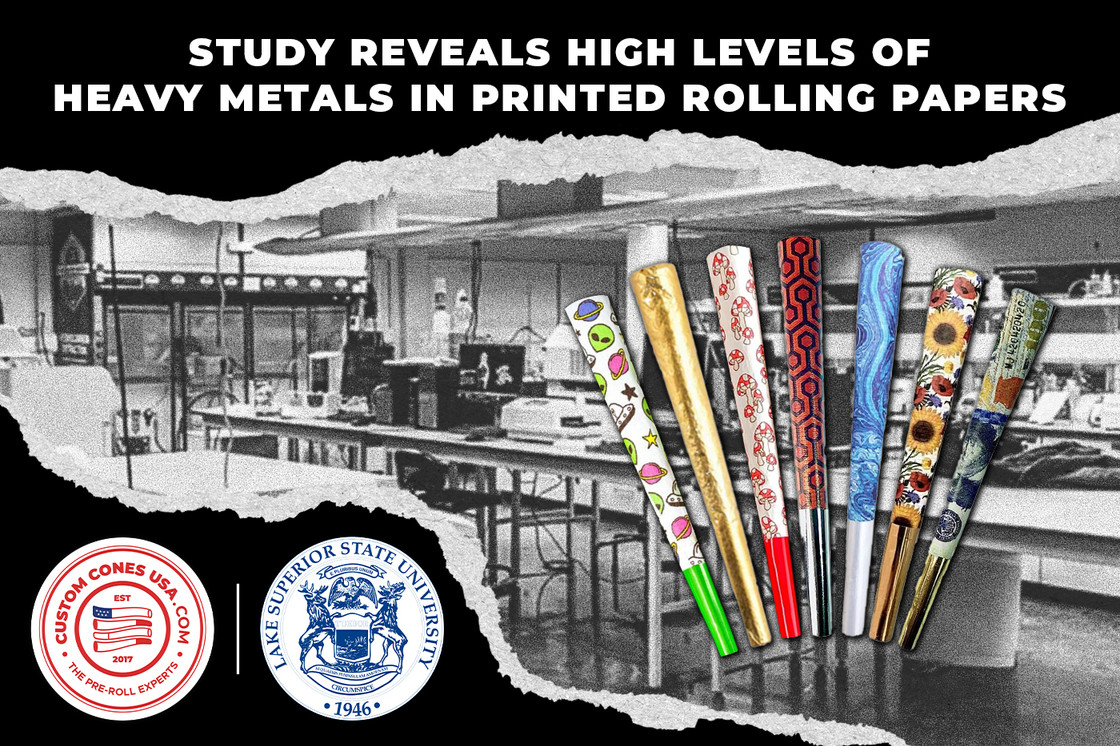Heavy Metals in Printed Rolling Papers
Posted by Custom Cones USA on May 10th 2025

The cannabis industry has evolved significantly over the past decade, with consumers demanding higher quality and greater transparency in the products they use. While much attention has been placed on cannabis cultivation and processing standards, rolling papers have largely gone unregulated despite being a core component of the smoking experience.
“After reading this study, we could not in good conscience continue to offer these papers to our customers and made the decision to remove all printed rolling papers from our website and warehouse,” said Harrison Bard, CEO and co-founder of Custom Cones USA.
A recent study conducted by Lake Superior State University (LSSU) revealed alarming levels of heavy metal contamination in printed rolling papers, raising serious questions about their safety when combusted and inhaled. In response, Custom Cones USA has made the decision to stop offering printed rolling papers altogether, effective immediately.
The Science Behind the Study

The study, led by Dr. Derek Wright and his team, examined 26 elements in various commercially available rolling papers using inductively coupled plasma mass spectrometry (ICP-MS), a highly sensitive analytical method. The results revealed that printed rolling papers contained significantly higher concentrations of metals such as copper, chromium, and vanadium compared to unprinted alternatives. One of the most significant discoveries was that blue and green inks in rolling papers were a primary source of copper, a metal that is commonly used in pigments but has not been studied extensively in the context of inhalation.

“Our results further suggest that copper-based pigments are used by a number of manufacturers and that regular use of these products might result in exposures as high as 4.5−11 times the maximum exposure limits.” said Dr. Wright, Professor of Environmental Sciences, facilities coordinator of the Micro Analysis and Spectroscopic Characterization (MASC) Lab, and the ICP-MS facility at LSSU.
These exposure limits were referenced against United States Pharmacopeia (USP 232) and International Council for Harmonisation (ICH Q3D) guidelines, which set strict limits for elemental impurities in pharmaceutical compounds. These standards ensure that metal contaminants remain within safe limits for human consumption, but rolling papers are not regulated under similar guidelines. This suggests that consumers could be unknowingly exposing themselves to unsafe levels of metal contaminants.
Exposure Potentials of Rolling Paper Samples Relative to Reference Exposure Values from USP 232 or ICH Q3D

This table summarizes the estimated daily exposure to 16 potentially toxic elements from commercially available cannabis rolling papers, modeled for two usage scenarios: moderate (2 g/day) and heavy (5 g/day) consumption. The values are compared against daily exposure reference limits set by USP 232 and ICH Q3D for inhaled pharmaceuticals. “Max” and “Median” represent the highest and middle exposure values across all tested products. The bottom three rows in each section show how many products exceed the reference limit, exceed 50% of the limit, or exceed 10% of the limit. Red indicates elements where exposure could exceed safe levels by 5x or more (even at 2 g/day), yellow indicates potential exceedances, and green signals no exceedance. Key elements of concern include copper (Cu), chromium (Cr), and vanadium (V), especially for heavy users.
“It is interesting that blue, green, and purple pigments registered excessive levels of copper because that does make sense from a chemistry standpoint,” said Dr. Riley Kirk, a Ph.D. in pharmaceutical sciences, cannabis chemist at the Cannabis Research Center & Coalition, and co-founder of The Network of Applied Pharmacognosy. Dr. Kirk’s research focuses on characterizing the transformation and rearrangement of Cannabis secondary metabolites during the making and how we can better predict what pharmacological effects this leads to.

“But I don’t believe people would assume that it was actual copper contributing to the color, so that was a shock to me reading this study,” added Dr. Kirk. “If you’re going to stay away from some printed paper, stay away from those three colors.”
Regulatory Gaps in Pre-Roll Testing
Rolling papers have historically been marketed based on aesthetic appeal and branding rather than safety or scientific research. Many consumers assume that if a product is sold for smoking, it must have passed some form of regulatory testing; however, rolling papers often are not held to the same safety standards as cannabis itself. Some jurisdictions, such as California and Michigan, require pre-rolls to be tested in their final form, meaning the entire pre-roll is analyzed for contaminants. However, most states only require testing the cannabis flower before it is rolled or filled into a pre-roll, leaving the safety of the paper itself largely unexamined.
Additionally, blunt wraps and other smoking accessories are not required to go through testing before they reach the consumer in the same way that tobacco products are. This lack of oversight has allowed potentially unsafe materials to remain on the market for years, despite their direct role in the combustion process.
Dr. Kirk challenged the notion of final-state pre-roll testing.
“Part of this conversation is that pre-rolls are very rarely tested in labs in their final state, and I don’t think they ever should be,” she said. “Labs shouldn’t be responsible for testing every single pre-roll to see if the papers and flower contain heavy metals; there needs to be a certain amount of responsibility put on every player in the game, and that includes the rolling paper companies, especially in a wellness industry like cannabis. All the pressure is put on the cultivators, but of course, if you’re combusting something, there needs to be some sort of responsibility taken when developing those papers and there should be a budget for research and development to make sure that they’re not including any excessive toxicants that can be more harmful than helpful to consumers.”
Bard agreed, noting that all of Custom Cones USA’s products are put through the same rigorous lab testing requirements as flower.
“When we founded Custom Cones USA, we were shocked to realize that the rolling papers and pre-rolled cones used to make pre-rolls were not fully tested, presenting a potential health hazard for consumers and possible testing failures for producers,” said Bard. “We test all of our products to the strictest standards in the industry for heavy metals, as well as pesticides and microbials, so pre-roll manufacturers can feel secure in the products they are sending to labs and store shelves.”

Standards and Regulations Critical to Concsumer Safety
Dr. Markus Roggen, a Ph.D. in chemistry and founder of Controlled Chemist, where his work as a cannabis chemist seeks to deepen the scientific understanding of cannabis, aiming to inspire revolutionary industrial applications, reemphasized the importance of testing products as they are consumed.
"Smoking is not just the transport of what’s in the flower to the user, there are chemical reactions happening in the process of smoking, so testing the joint before sale is meaningless, because the joint changes when you smoke it,” he said, “An easy example of this is if you have flower that has TCHa in it. You do not inhale THCa, you inhale THC, so we already know that one chemical reaction is happening, and then there is other chemistry happening too."
Simply put by Dr. Roggen, “You should test the product as it is consumed, not as it lies on a table.
The lack of regulatory requirements surrounding rolling papers and finished pre-rolls often means companies will avoid conducting tests that might reveal product issues.
“When it comes to testing, as long as there is no benefit for producers to know and it’s not required, they will not,” said Dr. Roggen. “Knowing that there are heavy metals in their products doesn’t do them any good. As long as they’re not required to perform those tests, they will be of little focus.”
Dr. Roggen explains that cannabis producers typically only pay for terpene testing when not required because they can advertise the results, but avoid testing for non-regulated, potentially harmful substances like heavy metals, since discovering problems offers them no benefit. He adds that this limited approach to testing has caused issues beyond heavy metals, with some cannabis producers experiencing health problems like bloody noses after failing to test non-cannabis ingredients in products like vape oils and tinctures, which can contain pesticides.
“These alternative sources of terpenes, for instance, oranges, are often sprayed with pesticides, which would make their whole batch fail.”
Behind the Shine of Gold Rolling Papers
The study also analyzed gold rolling papers, which have become popular as a luxury product in the cannabis space. Researchers found that these papers contained notable levels of silver and copper, metals commonly found in gold ores and alloys. Initially, gold itself was not measured using ICP-MS due to its high concentrations, which made it difficult to quantify accurately. However, researchers later analyzed the gold content using X-ray fluorescence (XRF) to better understand its composition. While the study did not investigate whether gold or other metals are released during smoking, the presence of these additional elements raises further questions about potential exposure. Prior research on gold nanoparticles suggests they could pose toxic risks if inhaled.
In a clinical study titled Subchronic Inhalation of Gold Nanoparticles, researchers conducted a controlled study exposing rats to 3 various levels of exposure to examine potential health effects of inhaled gold nanoparticles over a 90-day period. The study found that the inhaled gold nanoparticles accumulated primarily in the lungs and kidneys, with high-dose exposure causing observable changes to lung function.

“It is quite possible that this particular sample is relatively inert under normal smoking conditions. However, as inhalation of gold nanoparticles has been shown to result in translocation to secondary organs and bioactivity with size-dependent effects and cytotoxicity, an a priori assumption of low risk seems premature,” said Dr. Wright.
Areas of inflammation in the lung tissue were detected in rats exposed to these nanoparticles, with the scale of inflammation increasing in female rats based on the concentration of gold nanoparticles. A decrease in tidal volume, the amount of air that moves in or out of the lungs with each respiratory cycle, was detected in rats exposed to gold nanoparticles compared to control groups.
Dr. Kirk expressed concerns about consumer perceptions of these products.
“If there is gold, silver, and a rainbow on your paper, there’s got to be something there that’s contributing to the color, but maybe people aren’t associating it with ‘that might be harmful to my health.’ I don’t believe they’re considering the association, and they’re also trusting the rolling paper company, and the companies assert that the papers are tested, which they often are, and that they’re made with soy-based inks, which is what the manufacturers tell us. But Dr. Wright’s study finds that it doesn’t matter if they’re soy-based because they are soy-based with other elements in them. If these additional materials aren’t being regulated by the state, but the research and tests show that heavy metals are there, it’s our responsibility to stop selling that product and educate people.”
Addressing misconceptions about gold papers, Dr. Kirk noted, “With gold papers, people often believe that the gold doesn’t combust and that it gets left in the ash. But we don’t know if 100% is, and it most likely isn’t 100%, and it’s not pure gold either.”
Combustion Testing Critical for Consumer Safety
The research team at Lake Superior State University emphasized that more studies are needed to understand the full impact of inhaling metals from rolling papers, particularly since combustion conditions may alter how these elements interact in the body. Unlike ingesting heavy metals through food, which passes through the digestive system, inhalation provides a direct pathway to the bloodstream, increasing potential risks.

The lungs lack the natural filtration system of the stomach and liver, meaning that even small amounts of contaminants could have long-term consequences. One of the key uncertainties is whether these metals remain in the ash after combustion or become part of the smoke that is inhaled. Understanding this behavior is crucial, especially as regulators consider how pre-rolls should be evaluated for safety.
Darwin Millard, Technical Director for CSQ Cannabis Safety & Quality and Vice-Subcommittee Chair for ASTM International’s focus on Processing and Handling of Cannabis, whose work with ASTM contributes to the development and refinement of voluntary industry standards for cannabis, questioned the standards used for rolling papers.
“Glues for rolling papers should probably not be food grade; they should be an inhalation grade material, and what is that? That’s what we’re on a mission to figure out,” said Millard. “Just because something is food grade doesn’t mean it’s inhalation grade, things can also be inhalation grade but not food grade. Whatever contaminants and their limits which would make it fit to be inhaled would probably also be safe to ingest.”
The concern about heavy metals in cannabis products extends beyond rolling papers. “The question of heavy metals in smoke has been brewing for six years in the cannabis vape field,“ noted Dr. Roggen, “The question is what do you inhale and how much do you inhale?”
“Vapes received a lot of attention because of the EVALI Crisis in 2019, but joints have been left alone for a long time, and there is a public concern about heavy metals in smoking,” he said, referencing the 109 outbreaks of severe lung illness linked to the use of vaping products.
Varying Chemical Reactions During Combustion
Infused joints present new safety and testing challenges that traditional standards weren't designed to handle. Unlike regular joints, oil-infused pre-rolls behave more like vape cartridges surrounded by flower, making them a fundamentally different product that requires updated approaches to analysis and regulation.
“These are very early studies, but we see that infused joints produce different toxicants than simple flower joints,” said Dr. Roggen. “When you smoke an oil-infused joint, you see some of the same toxicants you saw in the flower pre-roll, some of the toxins you see more of, while others disappear. Others then show up that weren’t there before, it’s not just more of the same - it's different.”
Dr. Roggen suggests that infusing a joint changes the burn temperature, which alters chemical reactions during smoking. Their tests showed that toxicants weren’t present in the original material, indicating that harmful compounds were formed during combustion, not simply transferred from the ingredients.
Dr. Roggen noted that mixing different combustible materials creates additional concerns.
“I have early results from mixing cannabis and tobacco spliffs. You are not just inhaling cannabis or tobacco; you are inhaling something more, as the tobacco and cannabis react with each other. We see new things happen that we don’t see in a pure joint or pure cigarette, similar to the infused joint study.”

Their testing process involves similar equipment to Dr. Wright’s study: “We would use a smoke machine to capture samples, and the analysis is done on a high-resolution mass spectrometer,” said Dr. Roggen.
Building a More Transparant Industry
The prevalence of rolling paper as a means of cannabis consumption makes this an important topic for consumer education. “So many people smoke cannabis with paper that it’s worth talking about,” said Dr. Kirk. “I would like more transparency on all papers to show that they are tested. I think that would be something people would look for, especially those who consume a lot of cannabis and your really educated consumers. I think it would be beneficial to be able to scan a QR code and get a metals or pesticide report on that product.”
DaySavers, Custom Cones USA’s B2C pre-rolled cone brand, employs QR codes on their consumer products that link directly to lab reports for heavy metals, microbials, and pesticides.
If cannabis pre-rolls are ever subject to the same FDA approval process as traditional tobacco products, printed rolling papers could face significant scrutiny. Cigarettes, for example, have already undergone FDA regulation, and it is rare to see printed papers in the tobacco industry due to safety concerns. A combustion analysis of rolling papers would be critical in determining whether metals are being aerosolized and inhaled, as this would have direct implications for consumer health. Without this data, pre-roll manufacturers using these materials could face future hurdles if regulations increase.
Millard emphasized that adopting standards across the industry will take coordination and time.
Millard emphasizes that adopting standards across the industry will require coordination and a transitional period. Since the proposed standards are not laws or regulations, moving them into policy would require time for companies to retool and meet the new specifications. He suggeststhis kind of transformation would benefit from support by industry lobbyists to help guide a smooth, gradual rollout rather than an abrupt shift.
Dr. Kirk, in universal agreement with those consulted, highlighted the need for this study to be tested through pre-roll combustion.
“A smoke study would be valuable to see how much of these metals reach the consumer post-combustion to see how the amount of metals in the papers and the amount of metals inhaled correlate to how much is left over in the roach or the ash. That would be a very interesting study,” Kirk said. “With our elemental analysis capabilities through Clemson University, we could evaluate the ash and roaches as well as what has been combusted.”
Millard said he would likely move away from using printed papers until more data is available, though he acknowledged some businesses might take the opposite approach based on different priorities.
Custom Cones USA Drops Printed Pre-Rolled Cones in Response to Study
As more scientific data emerges, the industry will need to reconsider how rolling papers are made and what materials are used. Custom Cones USA, recognizing the potential risks highlighted in this study, decided to completely phase out printed rolling papers from its product lineup effective immediately. This decision reflects a growing trend in the industry, where health and transparency are becoming more important than branding gimmicks. While these papers may have once been seen as a way to differentiate products on the shelf, there is a growing recognition that visual appeal should never come at the cost of consumer safety.

“One point that Dr. Wright repeats is that these printed papers are potentially harmful, though not guaranteed. But if you know something is potentially harmful, just don’t do it,“ said Bard, noting that DaySavers, his company’s consumer brand, will not introduce printed cone products based on these findings. “It’s not definitive that once you combust these printed paper products, that it’s harmful, or to what degree it’s harmful, but knowledge of the potential risks requires us to take action.”
While Dr. Wright’s study centered on printed rolling papers, the broader takeaway is that consumers may be unknowingly exposed to harmful substances in alternative smoking materials. Dr. Kirk recounted a personal experience after smoking a rose petal blunt that left her mouth numb, raising concerns about the lack of safety evaluation for trendy, non-traditional materials.
Custom Cones USA Follows the Science
As Bard explained, rose petals are often treated with color-preserving chemicals and pesticides, highlighting why Custom Cones USA has taken proactive steps to eliminate questionable products, even beyond the scope of the study. In addition to discontinuing printed papers, the company previously dropped rose, palm, and tendu leaf pre-rolls due to concerns over pesticide exposure.
There is still much to learn about the long-term effects of inhaling certain rolling paper additives, but the current data suggests that removing unnecessary risks is the best course of action. The findings from this study underscore the importance of reassessing the materials used in rolling papers and suggest that manufacturers should be more cognizant in product design moving forward.
“As a consumer, I would just hope to see that products sold for smoking are fit for smoking, whatever that may mean,” Millard explains. “That should mean, at minimum, that the material being used is tested and that when combusted, doesn’t release harmful substances into the smoke.”
Given the study results, Millard said he would avoid printed papers and recommends that consumers do the same.
“I would also tell people to avoid papers that have been printed on with custom branding, graphics, or text. And certainly the gold ones, those seem to be pretty unsafe. I certainly would suggest that A) we err on the side of caution and avoid smoking gold or printed paper, and B) we should definitely be funding Dr. Wright’s team and others to do follow-up studies.”
Custom Cones USA is leading by example by making consumer safety the top priority rather than focusing on short-term sales. As the industry evolves and more research becomes available, other companies will hopefully follow suit, leading to a future where all inhalable cannabis products are designed with safety in mind first. In the meantime, consumers should be mindful of what is in their rolling papers and prioritize options that are free from unnecessary additives.
As science continues to develop, the industry must work together to raise the standards for product safety, ensuring that every aspect of cannabis consumption is as clean and responsible as possible.
Reducing Consumer Risks in the Pre-Roll Segment
“The bar could be raised when it comes to these consumption devices,” states Millard. “Not necessarily make them safe, but at least where we know that the paper isn’t causing the issue, but what's inside the paper. Reasonable assurance that the daily consumption rate of the combusted materials, like papers and glues, are less harmful than the daily consumption of what is inside the paper. That is where I would see value in having more data and actually having fit for purpose specification in the marketplace.”
“As one of the top pre-roll suppliers in the country, Custom Cones USA is committed to both testing and transparency,” added Bard. “We will continue to support and follow the scientific research to ensure customer safety and producer compliance in the pre-roll category and the cannabis industry in general, and update our inventory as needed.”
Elemental Composition of Commercially Available Cannabis Rolling Papers Derek Wright, Michelle M. Jarvie, Benjamin Southwell, Carmen Kincaid, Judy Westrick, S. Sameera Perera, David Edwards, Robert B. Cody
Dr. Derek Wright - Professor of Environmental Sciences, facilities coordinator of the Micro Analysis and Spectroscopic Characterization (MASC) Lab, and the ICP-MS facility at Lake Superior State University
Jackson Rund – Undergraduate Cannabis Business and Chemistry Student, Vice President of the LSSU Cannabis Club, and Co-Founder of Higher State Brands
Harrison Bard – Chief Executive Officer, Custom Cones USA
Dr. Riley Kirk - Cannabis Chemist at the Cannabis Research Center & Coalition and Co-Founder of The Network of Applied Pharmacognosy
Darwin Millard - Technical Director for CSQ Cannabis Safety & Quality and Vice-Subcommittee Chair for ASTM International’s focus on Processing and Handling of Cannabis
Dr. Markus Roggen – Cannabis Chemist and Founder of Controlled Chemist
Fredrik Rading – Chief Operations Officer, Custom Cones USA
James Valentine – Content & Communications Manager, Custom Cones USA
Brian Beckley – Senior Copywriter & Editorial Strategist, Custom Cones USA
The cannabis industry has evolved significantly over the past decade, with consumers demanding higher quality and greater transparency in the products they use. While much attention has been placed on cannabis cultivation and processing standards, rolling papers have largely gone unregulated despite being a core component of the smoking experience.










